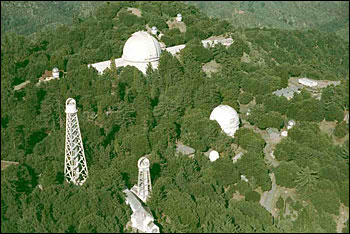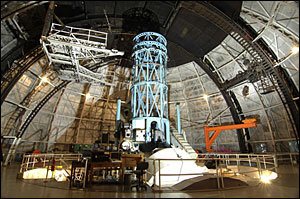
Fire Threatens Observatory
LOS ANGELES, Sept. 1, 2009 – A wildfire raging in Angeles National Forest is threatening the 105-year-old Mount Wilson Observatory, home to several of the most technologically advanced facilities in the world for studying astronomical objects with unprecedented resolution and clarity.
The Station Fire, the largest of five uncontained fires currently burning in California, has charred more than 122,000 acres (about 190 square miles) and destroyed 53 structures since beginning Aug. 26. As of Tuesday morning, the 3655 firefighters battling the blaze had contained only 5 percent. Authorities have estimated it could take weeks to fully contain the fire, the cause of which is still under investigation. More than 10,000 homes and 500 businesses remain threatened.

An aerial view of the Mount Wilson Observatory complex, looking northeast. In the lower left are the 60-ft and 150-ft solar tower telescopes. Directly below the 60-ft tower is the horizontal Snow solar telescope. The dome for the 60-in. telescope is to the right of center, and the dome for the 100-in. Hooker telescope is near the top-center. Below the 60-in. dome is the small white dome housing the 16-in. Meade telescope. Directly north of the 100-in. dome is the long beam-combining building for the CHARA interferometer. Five of the six small silvery CHARA domes, each housing a 40-in. telescope, can also be seen. To the right of the picture is the Berkeley infrared interferometer. (Photo by Norm Vargas, a 60-in. telescope operator)
Mount Wilson, home to broadcast towers for nearly 50 television and radio stations, is a major communications hub for all of southern California. It is also home to the historic Mount Wilson Observatory.
The observatory was founded in 1904 by George Ellery Hale, who brought the Snow solar telescope from Yerkes Observatory in southern Wisconsin to continue his studies of the sun. Hale and his colleagues developed new technologies to extract the information encoded in the light from distant astronomical objects, unlocking the secrets of life and death among the stars.
The observatory is home to the 100-in. Hooker telescope, named after John D. Hooker, who provided the funds for its giant mirror. It was the largest telescope in the world from 1917 to 1948, when the 200-in. telescope was built on Palomar Mountain 90 miles away. Discoveries made with the 100-in. telescope include Edwin Hubble’s landmark work on the expansion of the universe and the establishment of the cosmic distance scale. In 1919, the first optical interferometer ever used for astronomical research was used on the 100-in. telescope to measure the sizes of distant stars.

Mount Wilson Observatory’s 100-in. telescope. (Photo by David Jurasevich)
The 100-in. telescope, which is a National Mechanical Engineering Landmark, was inactive from 1986 to 1994, then underwent major upgrades to its control systems. A state-of-the-art adaptive optics system was developed to enable new high-resolution studies of astronomical objects, and the telescope is still in use today for experimental and long-term research programs. In recent years, astronomers from the California Institute of Technology, the Smithsonian Institution, the Jet Propulsion Laboratory, the University of Illinois and the US Naval Observatory have carried out a variety of projects on the telescope.
View to the west of wildfire conditions from atop the 150-ft Solar Tower at Mount Wilson Observatory, on Aug. 30 (top) and Sept. 1 at 9 a.m. (Images copyright ©UCLA Department of Physics and Astronomy)
The observatory’s solar towers collect data daily in what is the world’'s longest continuous record of the sun. The observatory has been operated by a nonprofit corporation since 1986. Guest institutions operating facilities on the observatory grounds include the University of California, Berkeley; Georgia State University; the University of California, Los Angeles; and the University of Southern California.
Mount Wilson Observatory Director Hal McAlister has been providing fire updates on the observatory’s Web site since Saturday. Since the observatory has been closed and all personnel evacuated, he has had to rely on images taken by the Webcam atop the 150-ft Solar Tower.
“Towercam scenes continue to show thick smoke on the mountain with a concentration on the right side of the image implying activity on the mountain’s north side. It clearly has not reached the mountain and, if advancing towards us, it is only doing so slowly,” McAlister posted today at 7:15 a.m. In a posting Monday morning, McAlister said, “... the good news is that the fire in the observatory’s vicinity seems to have diminished. The bad news is that there are no firefighters presently on the scene.”
Fire crews have been dousing the area around the broadcast towers with flame retardants for days. Forest Service officials reported Monday morning that they were optimistic that cooler temperatures and higher humidity will help them contain larger portions of the fire.
For more information on the fire, visit: www.inciweb.org
Published: September 2009